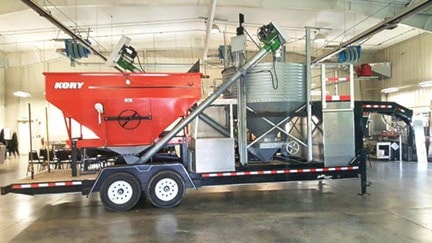A farm safety advocacy group is developing a mobile grain entrapment training unit aimed at demonstrating safety tips to prairie farmers.
The Canadian Agricultural Safety Association (CASA) announced Thursday, Dec. 17 in a press release it had joined forces with canola producer associations in Alberta, Saskatchewan and Manitoba to build a mobile entrapment demonstration unit. Impetus for the program came from the perceived need to give farmers important safety tips with regards to grain being moved from an auger into a hopper or bin, says Marcel Hacault, executive director for CASA.
The announcement has been met with positive response, especially after a first-responders training program in Nova Scotia helped save the life of one farmer. “They actually used their training to rescue a 20-year-old man,” said Hacault.
At the time of the announcement, there was enough money raised to build one training unit, but CASA’s goal is to raise $600,000 to build three units and have them operate around the country.
Besides the Manitoba Canola Growers Association (MCGA), the Alberta Canola Producers (ACP) and SaskCanola, Hacault says others have shown strong interest in the program. While grain suffocation is not the biggest danger on a farm, it has grown over the years.
Hacault says with bigger hoppers/bins and faster augers it doesn’t take long for person to be fully engulfed.
“As soon as you’re covered above the knees, you can’t get out,” explained Hacault of the danger.
He likened it to quicksand as there is no support within the hopper to remove oneself. Some of the reasons for a farmer going into a bin could be due to flow issues or crusted grains and Hacault feels this training unit will provide useful tips to stay out of harm’s way.
In the press release, CASA expressed satisfaction with the support of the canola associations, each of which have committed $30,000 over three years. The MCGA feels these training units will have long term benefits to the industry.
“They provide opportunities for agricultural workers, farmers and farm families across the prairies to learn about the importance of grain safety and spread awareness of the dangers of grain entrapment,” said MCGA’s Jack Froese.
“It is imperative that farm safety remain a top priority for our industry,” added Stuart Holmen of ACPC.
“The more organizations get involved and support farm safety initiatives, the more we are able to raise awareness for all farmers and farm families to mitigate risks they encounter on a daily basis,” stated Dale Leftwich of SaskCanola.
CASA is looking for support to improve the program and invites individuals, associations and businesses to check out the program or to provide support at www.casa-acsa.ca.
